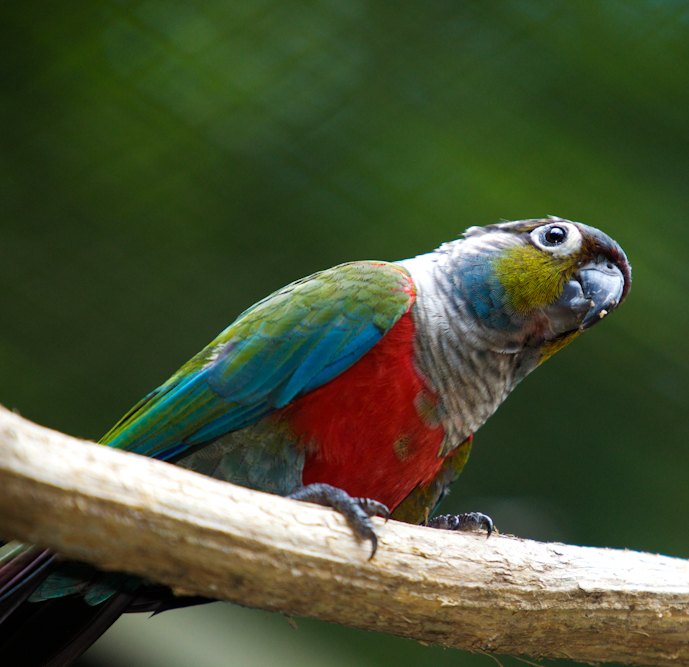Crimson Bellied Conure


About Crimson Bellied Conure
These playful, cuddly and affectionate little parrots are one of the best and most popular representatives of the Conure family. With a variety of desirable aspects and traits that are essential for great pet parrots, these little sweethearts are definitely quite the feathered charmers. Always highly sought after on the pet market, they can be a bit pricey, but it sure is worth it, because you get what many consider a perfect pet parrot. Just make sure to acquire one from a reputable source- Crimson Bellied Conure is a vulnerable breed.
One of the cuddlier conures, these affectionate parrots will love to bond and snuggle with their favorite person in the house.
Native Region/Natural Habitat
Like all the conures, Crimson Bellied Conure finds its home in South America. This particular breed lives in a region that is relatively small, and is centered on south-central Amazon Rainforest and covers parts of Brazil and Bolivia. They thrive in the “terra firma” tropical rainforests, forest edges, and secondary growth. Due to increasing deforestation and destruction of habitat these parrots are labeled as a vulnerable breed and measures are taken to preserve their populations. As a result, these birds are quite rare on the market, but they can still be found from time to time.
Sharing most physical traits with the other conure breeds, Crimson Bellied Conure is easily spotted by its distinct colors. Small head and beak, slender bodies and tapered long tail are some of the key features. The adults reach an average length of 9 inches (24 centimeters), a part of which is taken up by the tail feathers. They can weigh up to 4 ounces (100 grams). Conures are highly energetic and will require a spacious cage, even if they are considered to be small birds. Some free time around the house is also needed to satisfy their needs and provide the needed exercise.
Crimson Bellied Conure is one of the quieter breeds in this family of parrots, making them a good choice for all you apartment people. Their natural calls are rare and unobtrusive, consisting of low chirps and whistles. Their contentment and joy are often shown through soft, muffled chirps and murmurs, which are often heard during playtime. Even though they are not the best of talkers, they can learn a few words to repeat. It is more likely they will pick up common sounds to mimic, like alarms, barks or whistles.
One of the prettier conures, Crimson Bellied Conure displays a variety of lively colors arranged in interesting patterns and combinations. This makes them exceptionally beautiful and quite unique- looking. The body is full of different colors. The thighs, back, and wings are mostly green, with turquoise blue on the lower half of the wings and upper back. Their entire abdomen is strikingly red, giving them their name. It stands out as the center point and draws the eye. The head, neck, and chest are a mix of white and grey, combined in a unique pattern resembling scales. The cheeks are green, and the forehead is light blue. This stunning combination of colors and a variety of exotic shades is definitely a fresh look and a charming one at that.
With their cute appearance and a stunningly colorful plumage, these parrots are truly gorgeous.
In the Amazon rainforest, the Crimson Bellied conure will depend on a diet made of flowers, fruits, small insects and seeds. Additionally, they are also one of the rare breeds that frequently visit clay licks, where they get the vitamins they lack. A good commercial seed-based mix will be a perfect start for your pet’s diet. Supplement it with a variety of fresh fruits and vegetables, and you should achieve a balanced diet. Don’t forget the hygiene. This is a great base of a healthy bird. Showers, sprays, and baths are all great choices and are loved by all conures.
Although they are small and look cute and cuddly, these are actually quite hardy and enduring parrots. In optimal conditions and with enough good care, they will achieve their lifespan of 20 years. Compared to some species, this might sound like a modest lifespan, but it still gives you plenty of time to spend with your feathered friend. A big part of caring for these parrots is social interaction. These friendly and affectionate parrots will even depend on it. A bored conure will become increasingly noisier, then lonely, and can eventually become sick. Always find enough time to play with your pet parrot.
When bored and neglected, Crimson Bellied conures can become much noisier. This is a good sign to give them more attention.
For many, the Crimson Bellied Conure is the perfect pet parrot. With their friendly, affectionate and seemingly silly personality, they will charm you from the get-go. For anyone that is looking for a pet parrot that is laid back, cuddly and fun, this is the right choice. You should expect a lot of adorable moments with this bird, from them snuggling up to you or hiding in your clothes and hair, all the way to their goofy antics and fun games. And with some patient training, they can learn quite a few interesting tricks as well. All in all, it’s not that hard to see why Crimson Bellied Conure is such a loved and treasured pet parrot breed.
Photo credit: Krisztian Kapusi/Shutterstock; Nori Almeida/Wikimedia Commons; Beatriz Bukowitz/Wikimedia Commons

A proud mama to seven dogs and ten cats, Angela spends her days writing for her fellow pet parents and pampering her furballs, all of whom are rescues. When she's not gushing over her adorable cats or playing with her dogs, she can be found curled up with a good fantasy book.
More by Angela Vuckovic

























